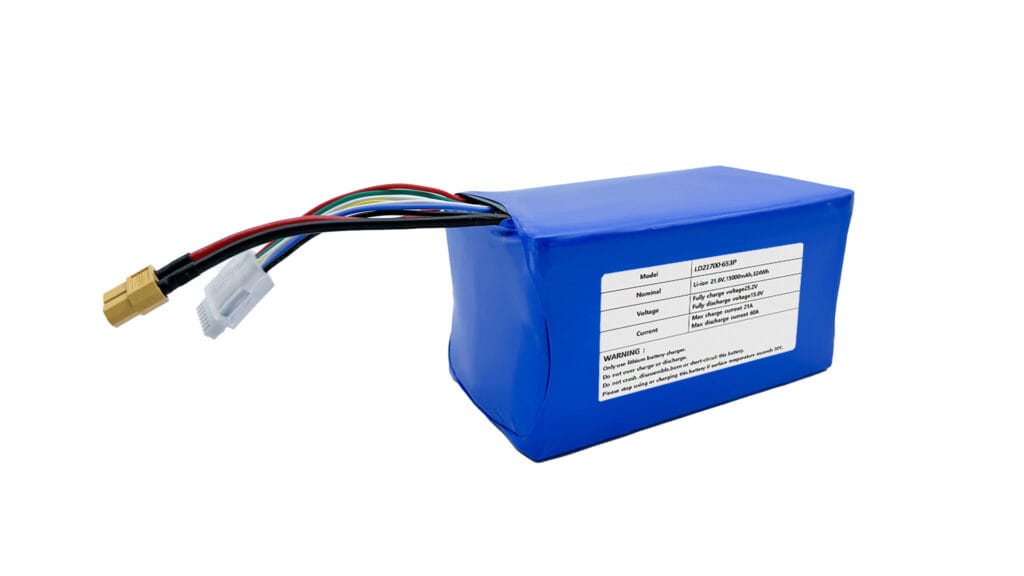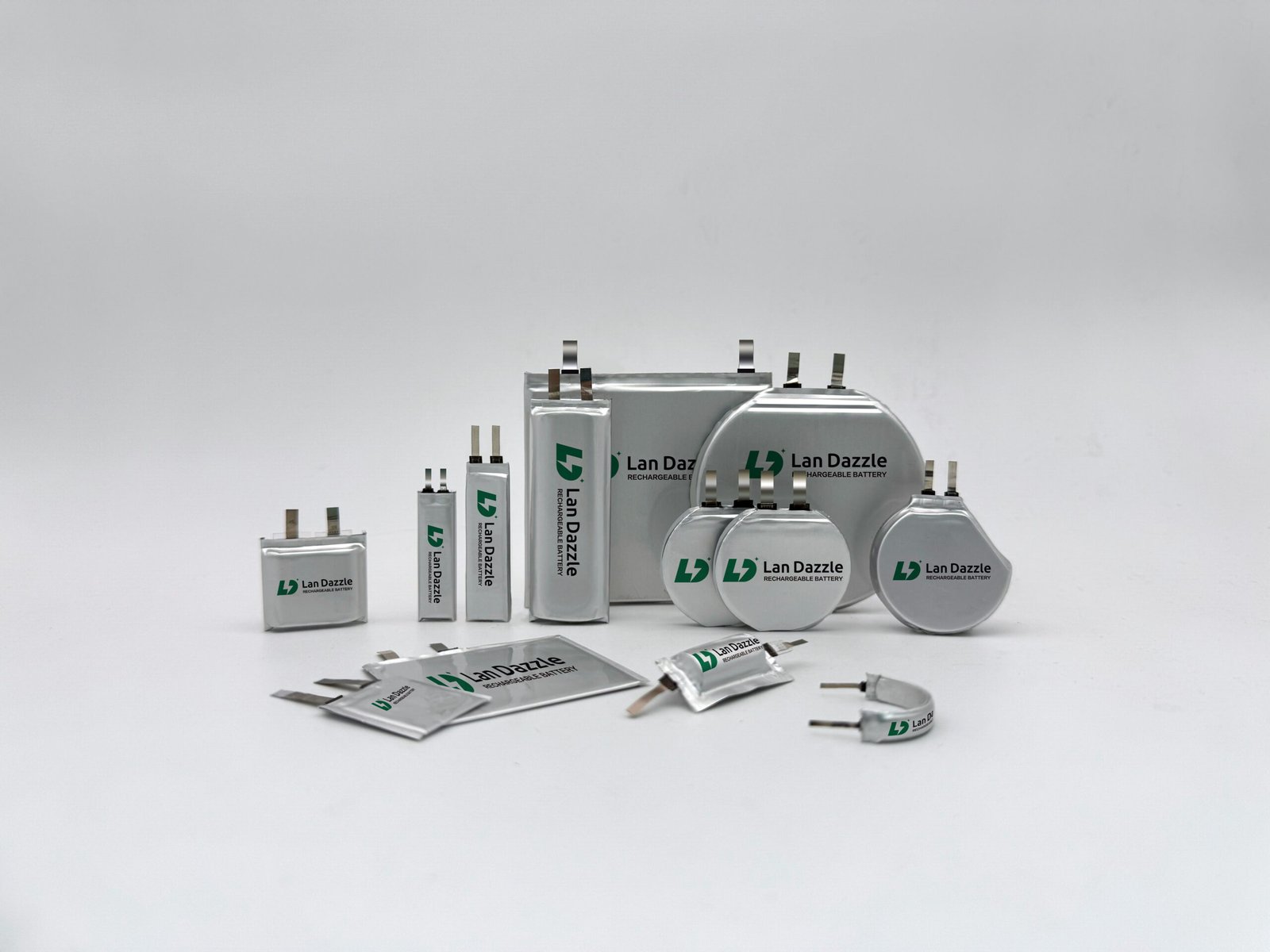14S 배터리의 기본 사항 이해하기
배터리 용어에서 "14S"라는 명칭은 다음과 같은 구성을 의미합니다. 14개의 개별 배터리 셀이 직렬로 연결됨. 직렬 연결에서는 각 셀의 전압이 합산되어 배터리 팩의 총 전압이 결정되며, 용량(암페어시, Ah 단위로 측정)은 단일 셀의 용량(동일한 셀 가정)과 동일하게 유지됩니다.
예를 들어 14S 리튬 이온 배터리 팩의 각 셀의 공칭 전압이 3.7V인 경우, 팩의 총 공칭 전압은 약 51.8V(14셀 x 3.7V/셀)가 됩니다. 이 높은 전압 출력은 14S 배터리가 가장 적합한 애플리케이션을 결정하는 핵심 특성입니다.
시리즈 구성에 따라 전압이 결정되지만 배터리 팩에 저장된 전체 에너지는 전압과 용량(에너지 = 전압 x 용량)의 곱이라는 점을 이해하는 것이 중요합니다. 따라서 용량이 더 큰 14S 배터리는 더 많은 에너지를 저장합니다.
모든 멀티셀 배터리 팩, 특히 14S와 같은 고전압 구성의 안전하고 효율적인 작동에 필수적인 것은 배터리 관리 시스템입니다. BMS는 개별 셀 전압, 온도, 전류 흐름 등 다양한 파라미터를 모니터링하고 관리합니다. 이를 통해 셀이 안전 한도 내에서 작동하도록 하여 과충전, 과방전, 열 폭주를 방지하고 궁극적으로 배터리 수명을 연장하고 안전성을 향상시킵니다.
14S 배터리 솔루션의 일반적인 애플리케이션
더 높은 전압을 제공하는 14S 배터리 솔루션 는 상당한 전력과 효율성이 요구되는 애플리케이션에 이상적입니다. 다음은 이러한 기술이 활용되는 몇 가지 일반적인 분야입니다:
- 전기 자동차(EV): 대형 전기 자동차는 종종 훨씬 더 높은 전압 시스템을 사용하지만, 14S 구성은 다음에서 자주 볼 수 있습니다. 전기 자전거, 전기 스쿠터 및 기타 경전기자동차. 전압이 높을수록 저전압 시스템에 비해 더 강력한 모터와 잠재적으로 더 긴 범위를 사용할 수 있습니다.
- 드론: 고성능 드론, 특히 다음과 같은 용도로 사용되는 고성능 드론은 상업, 산업 또는 전문 영화 촬영 목적는 14S 배터리 구성을 사용하는 경우가 많습니다. 전압이 높을수록 더 강력한 모터를 사용할 수 있어 더 큰 양력 용량, 더 긴 비행 시간, 더 무거운 탑재체와 정교한 장비를 운반할 수 있는 향상된 기동성을 제공합니다.
- 재생 에너지 저장: 소규모의 경우 태양광 또는 풍력 발전 시스템14S 배터리 뱅크는 인버터 및 기타 시스템 구성 요소에 적합한 전압을 제공하여 주거용 또는 소규모 상업용 애플리케이션의 에너지 용량과 전압 요구 사항 간에 균형을 맞출 수 있습니다.
- 무정전 전원 공급 장치(UPS): 더 높은 전력 UPS 시스템 산업용 또는 상업용으로 설계된 제품은 정전 시 중요한 작업을 유지하는 데 필요한 전압을 공급하기 위해 14S와 같은 배터리 구성에 의존하는 경우가 많습니다.
- 산업 장비: 다양한 산업 기계, 로봇 공학 및 고전압 공구 는 14S 배터리를 사용하여 전력을 공급하므로 효율적이고 견고하게 작동할 수 있습니다.
- 해양 애플리케이션: 보트에서 전기 추진의 채택이 증가함에 따라 14S 배터리는 다음과 같은 분야에서 사용되고 있습니다. 전기 보트 모터 및 보조 동력 시스템는 기존 연소 엔진에 비해 더 깨끗하고 조용한 대안을 제공합니다.
이러한 애플리케이션 시장은 크게 성장하고 있습니다. 예를 들어, 전 세계 전기 자전거 시장은 2023년에 1조 4,000억 달러 이상의 가치를 지니고 있으며 앞으로도 상승세를 이어갈 것으로 예상됩니다(출처: 업계 보고서). 이러한 성장은 14S 구성과 같은 배터리 솔루션의 중요성이 점점 더 커지고 있음을 보여줍니다.
14S 배터리의 장점
14S 배터리 구성을 선택하면 몇 가지 주요 이점이 있습니다:
- 더 높은 전압 출력: 가장 큰 장점은 낮은 직렬 구성에 비해 전압이 증가한다는 점입니다. 전압이 높아지면 연결된 부하에 더 많은 전력을 공급할 수 있습니다. 동일한 전력 요구 사항(전력 = 전압 x 전류)의 경우, 더 높은 전압의 시스템은 더 적은 전류를 소비합니다.
- 전류 소모량 감소: 동일한 전력 출력에서 전류가 낮아지면 배선의 저항 손실이 줄어들고 잠재적으로 열 발생이 줄어드는 등 여러 가지 이점이 있습니다. 이는 시스템 효율성 향상과 부품 수명 연장으로 이어질 수 있습니다.
- 특정 모터 및 인버터 시스템에 대한 적합성: 많은 고성능 전기 모터와 인버터는 특정 전압 범위에서 작동하도록 설계되었습니다. 14S 배터리는 이러한 구성 요소의 최적 작동 범위에 속하는 경우가 많으므로 효율적인 전력 전송과 성능을 보장합니다.
- 더 작은 와이어 게이지의 가능성: 고전압 시스템에서 전류 소모량이 적으면 성능이나 안전성을 저하시키지 않으면서도 더 얇고 가벼운 배선을 사용할 수 있어 전체 시스템의 무게와 비용을 절감할 수 있습니다.
- 확장성: 단일 14S 팩은 특정 전압을 제공하지만, 여러 개의 14S 팩을 병렬로 연결하여 전체 용량(Ah)과 총 에너지 저장량을 늘릴 수 있으므로 다양한 에너지 수요를 충족할 수 있는 확장성을 제공합니다.
다른 시리즈 구성과 비교한 14S 배터리
| 기능 | 8S 배터리 | 12S 배터리 | 24S 배터리 | 48S 배터리 |
|---|---|---|---|---|
| 공칭 전압 | 24-29.6V | 36-44.4V | 72-88.8V | 144-177.6V |
| 일반적인 애플리케이션 | 중급 전기 자전거, 일부 드론, 휴대용 발전소 | 고출력 전기 자전거, 대형 드론, 일부 전동 공구 | 일부 전기차(특히 소형 전기차), 주거용 에너지 저장 장치 | 일부 차량 시스템, 대규모 에너지 저장 장치, 그리드 규모 애플리케이션 |
| 주요 이점 | 성능, 크기, 비용의 균형이 잘 잡혀 있으며 널리 사용 가능한 구성 요소 | 8S보다 높은 전력 출력으로 더 까다로운 애플리케이션에 적합 | 고전력 시스템에서 더 높은 효율성, 고전류 애플리케이션에서 더 얇은 배선 가능 | 초고전력 시스템에서 배선 간소화 및 잠재적으로 더 낮은 전류 소비 |
| 잠재적 단점 | 고성능 애플리케이션에는 전력이 부족할 수 있습니다. | 8S에 비해 복잡성 및 비용 증가, 더 높은 전압 부품 필요 | 전압이 높을수록 안전 문제가 발생할 수 있으며, 낮은 전력 수요에 비해 과도할 수 있습니다. | 더 크고 비싼 경우가 많으며 특수 고전압 부품이 필요합니다. |
14S 배터리 솔루션 선택 시 고려해야 할 요소
적절한 14S 배터리 솔루션을 선택하려면 몇 가지 요소를 신중하게 고려해야 합니다:
- 애플리케이션의 전압 요구 사항: 가장 중요한 요소는 14S 배터리의 공칭 및 작동 전압 범위가 모터, 인버터 또는 기타 연결된 장치의 전압 요구 사항과 호환되는지 확인하는 것입니다.
- 용량 및 범위/런타임: 원하는 암페어시(Ah) 용량에 따라 총 에너지 저장량이 결정되므로 EV의 범위 또는 UPS의 런타임이 결정됩니다. 이는 애플리케이션의 에너지 소비 요구 사항을 기반으로 계산해야 합니다.
- 세포 화학: 다양한 리튬 이온 화학(예: NMC, LFP, NCA)은 에너지 밀도, 사이클 수명, 안전성 및 비용 측면에서 다양한 특성을 제공합니다. 14S 팩 내 셀의 화학 물질 선택은 전반적인 성능과 애플리케이션에 대한 적합성에 영향을 미칩니다. 예를 들어, 리튬인산철(LFP)은 안전성과 긴 사이클 수명으로 잘 알려져 있으며, 니켈망간코발트(NMC)는 더 높은 에너지 밀도를 제공하는 경우가 많습니다.
- 안전 기능 및 BMS: 14S 팩의 높은 전압을 고려할 때, 안전한 작동을 보장하고 셀 불균형을 방지하며 배터리 수명을 최대화하려면 견고하고 안정적인 배터리 관리 시스템이 가장 중요합니다. 과충전 및 과방전 보호, 온도 모니터링, 셀 밸런싱과 같은 BMS 기능을 살펴보세요.
- 주기 수명 및 내구성: 배터리의 예상 수명(충전-방전 주기로 측정)은 애플리케이션의 요구사항과 일치해야 합니다. 온도 및 방전 깊이와 같은 작동 조건은 사이클 수명에 영향을 줄 수 있으므로 고려하세요.
- 비용 및 가용성: 14S 배터리 팩의 비용과 평판이 좋은 공급업체로부터의 구매 가능 여부는 현실적으로 중요한 고려 사항입니다. 성능 요구 사항과 예산 제약의 균형을 맞춰야 하는 경우가 많습니다.
결론
14S 배터리 솔루션은 높은 전압과 관리 가능한 복잡성의 매력적인 조합을 제공하므로 경전기부터 산업용 장비 및 재생 에너지 저장 장치에 이르기까지 다양한 애플리케이션에 다용도로 사용할 수 있는 전원 공급원입니다. 직렬 구성의 기본 사항, 고전압의 장점, 14S 배터리 선택 시 고려해야 할 중요한 요소를 이해하는 것은 엔지니어와 최종 사용자 모두에게 필수적입니다. 기술이 계속 발전함에 따라 14S 배터리는 의심할 여지 없이 우리의 미래에 점점 더 중요한 역할을 하게 될 것입니다.
랜 대즐 14S 배터리 솔루션
랜대즐은 단순한 배터리 공급업체 그 이상입니다. 비즈니스 성공을 위한 파트너입니다. 14S 배터리 솔루션은 오늘날의 까다로운 환경에서 성공하는 데 필요한 전력, 신뢰성, 안전성을 제공하도록 설계되었습니다. 소니는 혁신과 품질에 전념하여 배터리가 현재 요구 사항을 충족할 뿐만 아니라 미래의 성장에도 힘을 실어줄 수 있도록 최선을 다하고 있습니다.
또한 다음과 같은 기능을 제공합니다. 다양한 직렬 및 병렬 배열로 구성을 사용자 지정할 수 있습니다. 이를 통해 특정 전압, 전류 및 용량 요구 사항에 완벽하게 맞춤화된 배터리 솔루션을 확보하여 고유한 애플리케이션의 효율성과 성능을 극대화할 수 있습니다. 필요한 사항이 있으면 언제든지 다음 주소로 문의하세요. info@landazzle.com 또는 방문 landazzle.com.

자주 묻는 질문
- 배터리 용어로 "14S"는 무엇을 의미하나요?
- 전체 전압을 높이기 위해 14개의 개별 배터리 셀을 직렬로 연결한 배터리 팩 구성을 말합니다.
- 14S 리튬 이온 배터리의 일반적인 전압은 얼마인가요?
- 개별 셀의 공칭 전압에 따라 다르지만 일반적인 3.7V 공칭 리튬 이온 셀의 경우 14S 팩의 공칭 전압은 약 51.8V입니다.
- 14S 배터리의 일반적인 용도는 무엇인가요?
- 전기 자전거, 전기 스쿠터, 소규모 에너지 저장 시스템, UPS 장치 및 일부 산업 장비에 자주 사용됩니다.
- 14S와 같은 고전압 배터리 구성을 사용하면 어떤 이점이 있나요?
- 전압이 높을수록 동일한 전력 출력에서 소비되는 전류가 낮아져 잠재적으로 효율성이 향상되고 전선을 더 작게 만들 수 있습니다.
- 전압이 높을수록 동일한 전력 출력에서 소비되는 전류가 낮아져 잠재적으로 효율성이 향상되고 전선을 더 작게 만들 수 있습니다.
- 애플리케이션에 맞는 14S 배터리를 선택할 때 고려해야 할 요소는 무엇인가요?
- 주요 요인으로는 시스템의 전압 요구 사항, 원하는 용량, 셀 화학, 안전 기능, 배터리 관리 시스템 등이 있습니다.





